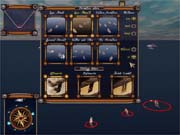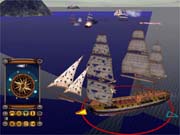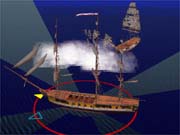Without a doubt, TalonSoft's Age of Sail II is the best serious simulation of fighting sail combat to date. However, since its competition includes lackluster games such as the original Age of Sail, Wooden Ships & Iron Men, and the Man of War games, being the best in its class doesn't necessarily say much about the game. Thus even though Age of Sail II can rightfully claim "best of breed" status, it does so in spite of numerous technical bugs and other flaws. Developed by Akella, which recently made the swashbuckling role-playing game Sea Dogs, Age of Sail II is a perfect example of a game that was released before it was finished or adequately play-tested.

Age of Sail II is the follow-up to the original game from 1997. The sequel is a fully 3D real-time naval combat game. It includes more than 100 individual historical scenarios and six campaigns (a seventh is included with the game's first patch), all taking place between 1775 and 1820. The scenarios range from small ship-to-ship actions, such as the Constitution vs. Guerriere, up to massive fleet battles like the battles of Camperdown and Cape St. Vincent. A handful of hypothetical scenarios are also included--one lets you see how a squadron of American ships-of-the-line would do in battle against British forces at the tail end of the War of 1812. No scenario editor is included in Age of Sail II, but the sheer number of scenarios available in the game is quite impressive.
A few of the campaigns are merely strings of scenarios sharing a common theme--for example, all of the major US-British engagements of the War of 1812--while others let you amass and manage a fleet through a course of several increasingly difficult engagements. Age of Sail II does not offer a randomly generated campaign (a prominent feature in the original Age of Sail), but the scripted campaigns included with the game are rather good for the most part.
Fans of the original Age of Sail will notice fairly quickly the major graphical improvements in the sequel. The 3D engine, which uses the same technology as in Sea Dogs, is stunning. Every ship in the game is highly detailed--right down to tiny sailors running about on the decks of each ship--and the battle damage sustained by the vessels is well depicted by the ripped sails, fires, and shattered hulls evident throughout the game. The engine does have a few minor problems, such as the polygonal clipping that occurs when ships sail too close to land--but by and large, the graphics in Age of Sail II are excellent. In addition, the music suits the theme well, and most of the sound effects are also very good, although the cannon sounds are a bit subdued. It's true that the game seems similar to Sea Dogs, which had a few awkward town sequences that didn't look as good as the ship-to-ship combat. But aside from having a similar 3D engine and theme, the tactical Age of Sail II has very little in common with the simpler, more character-driven Sea Dogs.

The landmasses are a new feature in Age of Sail II. In scenarios that take place within sight of land, an array of new elements come into play. Shallow water and shoals are treacherous hazards for commanders, and they add a welcome strategic consideration to many of the battles in the game. A depth-sounding feature lets you keep a lookout for shallow water.
Occasionally, when fighting near landmasses, you'll also face off against fortresses along the shore. A number of the scenarios in Age of Sail II include fortresses of varying strength, which is great for the sake of variety. Unfortunately, they do not always work properly or pose the significant threat that they should. In some missions, fortresses sit idly by without firing a single shot, while in others they inflict scarcely any damage at all.
Command and control in Age of Sail II is fairly intuitive. You can click on a ship on the screen or select its name from a ship list. For each ship, you can control what type of shot to use, where to aim, and a variety of other critical crew tasks. In fact, the crew allocation screen is one of the most useful features in the game. From here, you can assign a portion of your crew to repair damage, put out fires, or refloat a grounded ship. You can also control the size of your boarding parties and prize crews for capturing enemy ships. Some of the menu options on this screen are useless--for example, the gun repair option--but most of them are incredibly useful, especially in lengthy battles where active repair crews can mean the difference between victory and defeat.
You can also assign ships to specific groups and issue different fleet orders for each group under your command. However, the fleet-orders system does not work terribly well; you will often find that the ships under your command seem to have little regard for your orders. For example, after you designate and select a group of ships, you may order that group to move into a specific formation (such as "line ahead") and adopt a general tactic (such as "offensive"). For some reason, the game does not let you select a formation and tactical approach before a scenario actually begins, despite the fact that in real-life battles of this kind, commanders typically had time to do so before any shots were fired. Instead, in Age of Sail II you have to scramble into position as soon as a scenario begins--and the battles often start with the enemy already in firing range, which can be frustrating.

Even then, as soon as you issue your formation and tactics edict, your ships will often seem to go haywire trying to follow your directions. In one such attempt, four ships in an eight-ship squadron immediately hove to and sat idle, three others shot off at full speed (each in a different direction), while the last ship ignored the order entirely and sailed headlong into the middle of an enemy fleet. All of this occurred while the enemy ships sailed on in a neat line of battle. Clearly, the formation commands were not properly implemented, so in most cases you are better off ignoring them entirely and just directing each ship individually.
Once you do engage the enemy, you may not always be pleased with the results. While the game handles small-scale battles extremely well, it has major problems simulating larger fleet actions. In particular, one of the bigger battles included in the game--the Battle of Copenhagen--is completely unplayable in the retail version of the game because of how badly the game slows down. Even a fast computer with a powerful 3D card has trouble running this battle at anything above four or five frames per second. And while the inclusion of a large landmass may contribute to the problems with that particular scenario, entirely seaborne battles such as Trafalgar don't fare much better. Despite its good looks, it's clear that the game's 3D engine needs some serious tuning if these battles are going to be possible.
Even in the smaller scenarios that are easier on your computer, there are two key flaws in the game that will keep you from enjoying them to their fullest. The first is the game's infuriating implementation of time limits in many of the missions. When simulating naval combat, time limits are acceptable for ending a scenario that has clearly run for too long--or to wrap things up if one side flees from battle. But when you're yardarm-to-yardarm with an enemy vessel, or closing in to grapple, board, and carry the day, the scenario simply should not end unless you are given the chance to confirm or deny that option. Perhaps fewer victory points could be awarded to commanders who take too long to win a battle. But because the game counts a draw as a loss to the player, the often strict time limits can severely impair your chances of winning some of the more difficult campaign battles.

The second flaw is less severe, but it is also frustrating: Many scenario briefings include extraneous, misleading, or just plain incorrect information. For instance, in the second mission of the Great Fleets campaign, you are told that you will receive a certain number of victory points for every ship that reaches the objective area. But when the mission begins, there is no objective area. Furthermore, the ships you are supposed to be escorting are nowhere to be found. In reality, your goal is to engage and destroy the French ships sailing toward you as the scenario begins, though the briefing never says anything to that effect.
The game has several other, lesser problems such as the absence of Napoleonic tricolor flags (French ships fly the Bourbon flag regardless of the year), a scrolling ship-list window that doesn't always scroll, computer-controlled ships that hurl themselves onto (and sometimes into) the nearest landmass, and a few nonfunctional menu options that govern the use of various graphical details. Also, the game often crashes while you're trying to reload a previously saved campaign. When you get down to it, Age of Sail II probably has too many minor problems to list in the context of a review. And yet, in spite of all these issues the game can be very enjoyable at times.
That's because the underlying design of Age of Sail II is very good, and its graphics are excellent. In many cases, the drama and tension of the real-life time period are very well portrayed during the scenarios and most of the campaigns. But clearly, the game was published before it was finished. So, despite the very solid design and some outstanding features and gameplay elements, you might be very frustrated with Age of Sail II because of all its technical problems. It's true that, thanks to the dearth of fighting sail games on the market, fans of the era may be able to look past most of these problems. But even hard-core naval buffs will have to keep their fingers crossed that TalonSoft will eventually address the game's most glaring flaws.